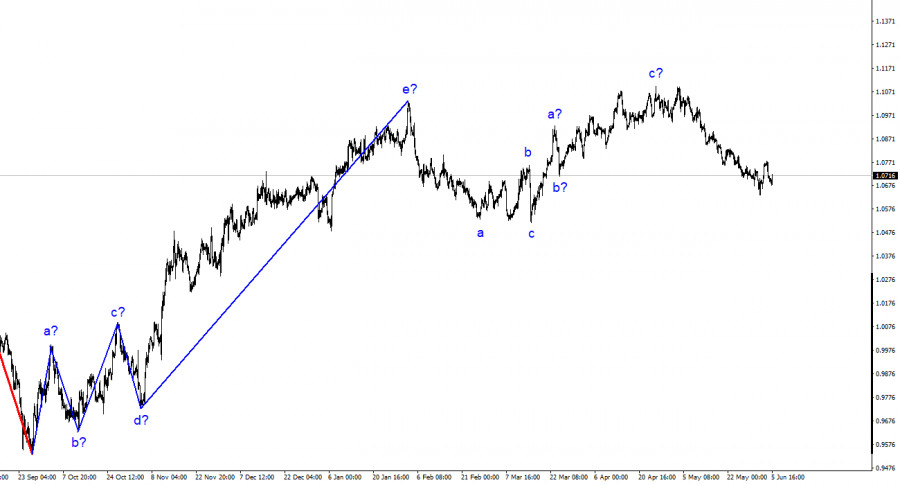

The wave analysis of the 4-hour chart for the euro/dollar pair continues to be non-standard but understandable. The quotes retreat from the previously reached highs, so the three-wave upward structure can be considered complete. The entire ascending trend segment may assume a more complex structure. Still, at the moment, I expect the formation of a downward trend segment, which is likely also to be a three-wave structure. Recently, I have regularly mentioned that I expect the pair to be near the 5th figure, from which the upward three-wave structure began.
The top point of the last trend segment was only a few tens of points higher than the highest point of the previous upward trend segment. Since December of last year, the pair's movement can be considered horizontal, and such a character of movement will be maintained. If this assumption is correct, then the formation of an upward wave "b" will begin (or has already begun), and the overall decline of the pair will continue after its completion.
The ECB can still tighten monetary policy. The exchange rate of the euro/dollar pair remained unchanged on Monday. It stayed the same, thanks to the ISM report in the USA, which I will discuss shortly. It is important to understand that for most of today, the European currency has been declining, and the rise began just an hour after the release of the report above, whose value turned out to be weaker than the market's expectations. However, before the release of the ISM index, the Eurozone's business activity indices became known. In the services sector, business activity declined from 56.2 points to 55.1 in May, and the composite index decreased from 54.1 to 52.8. It may not be the strongest decline, and both indices remain above the key 50.0 mark, but a negative trend is emerging. These two reports could have reduced demand for the US currency in the first half of the day.
Business activity in the manufacturing sector has long been below 50. This means that the manufacturing sector is not growing, and without its growth, it is difficult to expect GDP growth, which has been close to zero for two quarters already. The recession has not started yet, and the ECB assures it will not start. However, the higher the interest rate grows (and it will continue to rise at the next meeting), the higher the probability that the services sector will also "fall" into negative territory. And along with it, the GDP will decline. Therefore, the euro currently has little support. Today, it was saved from a decline by the ISM index in the USA, and in the coming weeks, wave analysis may come to its aid (a corrective wave needs to be built). However, I still expect a continuation of the pair's decline in the future.

Based on the analysis, the upward trend segment formation is complete. Therefore, it is advisable to recommend selling, as the pair has ample room for decline. I still consider the targets around 1.0500-1.0600 quite realistic, and I advise selling the pair with these targets. From the level of 1.0678, the formation of a corrective wave may begin (or has already begun), so I recommend new sales in case of a successful attempt to break through this level or after an obvious completion of wave "b."
On a larger wave scale, the wave labeling of the upward trend segment has taken on an extended form but is likely to be completed. We have seen five upward waves, most likely the structure of a-b-c-d-e. Forming a downward trend segment may still need to be completed, and it can take any form and length.